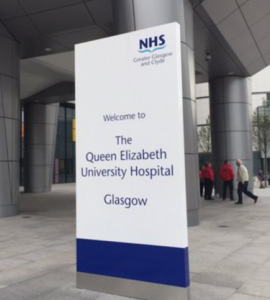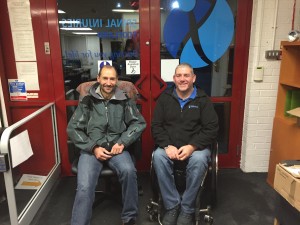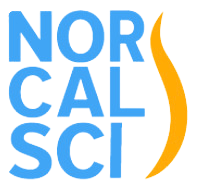In the first Blog of 2016, Nick, who is one of the SCI Peer Supporters at SCVMC, describes his visit to the The Queen Elizabeth National Spinal Injuries Unit (QENSIU), The unit is part of the Queen Elizabeth University Hospital in Glasgow, Scotland.
I was really excited about the visit. I had already signed up to Spinal Injuries Scotland (SIS) and was very impressed with the information packet they had sent me. SIS is a charitable organization whose focus has been primarily Information, Advice, Support and Education for people with a spinal cord injury, their family, friends and those that care for them.
http://www.sisonline.org
Oh, and did I mention the SIS Honorary President, HRH The Princess Royal. For those of you not familiar with the British Royal Family, Her Royal Highness Princess Ann is the daughter of the Queen and a huge fan of the Scottish Rugby Team.

Just after noon on a wet and windy 21st of December, I got off the Edinburgh to Glasgow Train at Glasgow Central Station. I then made my way on foot over The King George V Bridge across The River Clyde to the Bridge Street Subway Station. I was following instructions on Google Maps for this 11 minute walk. What Google Maps had failed to mention there was a gale blowing straight down the bridge, driving rain into my now sodden Levis, welcome to Glasgow indeed!

I was meeting Dougy Johnstone (Pictured above) at the SIS Office in Brand Street in Govan, an area of Glasgow south of the river. Dougy is the Peer Support Manager for SIS and was to be my host for the day. The Glasgow Subway is the 3rd oldest Subway System in the world and looks good for 120 years old. However, back in 1896, there was no contingency made for wheelchair users so is only really suitable for the able bodied. I reached my destination in 4 stops and when I got above ground, I called Dougy to let him know I had arrived. I had a short walk to the offices where Dougy was waiting at the door for me. Dougy introduced me to Roslyn, The SIS General Manager, he also explained there were 3 other SIS staff members but as it was only 4 days to Christmas, they had already started their holiday vacation. Although small, the office was very well organized with a rack packed with professional looking literature relating to all aspects of SCI and resources.
Dougy gave me a clear and concise overview of SIS as well as explaining the programs in place for transportation following an SCI. He told me, "There is an allowance available to the disabled, a portion of which can be used to lease a new vehicle through the Mobility Scheme. This benefit is awarded with the proviso that it will be required for 3 years for a modified vehicle and 5 years for a highly modified vehicle." My takeaway was that you can get a new car with the all the necessary modifications effectively for free. This was my first indication that the National Health Service (NHS) and British Welfare State operates very differently to what is in place in California.
We needed to get to the Queen Elizabeth University Hospital by around 1:30pm where Dougy had organized a tour of the Phillipshill Ward and a meeting with the Staff. He also needed to meet two members of his Peer Support Team who would be visiting the patients that day. The Phillipshill Ward is the SCI Rehabilitation Center for Scotland and has over 30 patients at various stages in their rehab. The length of stays in Phillipshill are more similar to the durations enjoyed at SCVMC by SCI patients 10 to 20 years ago, when they spent between 3 to 9 months in rehab before transitioning to home. I followed Dougy out to his car, a crossover SUV. He laid a towel down on the door sill before transferring into the drivers seat. He then quickly dismantled his chair and laid it on the back seat on another strategically positioned towel protecting the leather upholstery. I then got into the passenger seat and we started our 10 minute journey to the brand spanking new Queen Elizabeth University Hospital. As we chatted on the journey, Dougy said the 4 wheel drive comes in useful accessing locations for his fishing and shooting trips he takes his now adult son on. I also learnt that Dougy had a solo motor bike accident 16 years ago which left him paralyzed below his waist. He admits it was hard for him at first to come to terms with his condition as he felt that he would no longer be a suitable father to his two year old son nor be a good husband to his wife. After spending 9 months in rehab, Dougy returned to work at Compaq Computers but was made redundant after 6 months. He then took full advantage of the programs available to him and graduated from University with a degree in Multimedia Technology. He became involved in the Peer Support Program and SIS and from what I can see, has transformed the organization with his energy, compassion and effectiveness.

As we approached the impressive hospital building, Dougy informed me that the new facility replaced 4 older hospitals in the Glasgow area. The actual QENSIU was built 23 years ago and was formally opened by Her Majesty the Queen on 14th December 1992. The unit now enjoys the benefits of being adjacent to the brand new Institute of Neurological Sciences. It was no surprise to Dougy that all the spots were taken in the parking structure but using his local knowledge he managed to park in the hospital grounds adjacent to the Philipshill Ward. I followed Dougy as he rolled around the single story building to the Rehab entrance. As we approached the entrance, Dougy said hello to the 4 patients huddling in their wheel chairs outside the entrance getting their nicotine fix. We joked that there were no bounds to human ingenuity and endurance when it came to securing the opportunity for a cigarette.

I followed Dougy through the automatic doors at the entrance which led to a spacious lobby, we were both relieved to get out of the driving rain. Through the glass panels, I could see a few patients hanging out in the large day room. After registering, Dougy then took me into the day room where I was introduced to Kiera and Nathan, the Peer Support Volunteers on duty that day. They make themselves available to the patients in the day room before starting their afternoon visits round the ward itself. As we chatted about the atrocious weather that day, Kiera informed me that her journey to the Hospital went relatively smoothly, "It's only 50 minutes by car and a short 20 minute ferry crossing from Dunoon." she quipped. Nathan had what I would say was a more reasonable journey, a 50 minute drive from his home town of West Calder which is between Glasgow and Edinburgh. Nathan was back in Scotland for the Christmas and New Year vacation as he is now spending most of his time in Shropshire, England, where he trains as an archer for the British Para Olympic Squad at The Lilleshall National Sports and Conferencing Centre. I smiled to myself as not only was I getting to meet some cool people, I was also hanging out with an elite sportsman. Dougy then introduced me to Helena who is the units Education Sister. She apologized that she had a meeting to attend with the rest of the medical staff and would not be able to accompany me during the tour but left that in Dougy's capable hands. Helena did say that she and the rest of the staff would like to meet me later that afternoon which I was very much looking forward to.
Dougy led the way round the wide corridors of the ward, our first stop was the hydrotherapy pool. This was an impressive facility easily viewed from the main corridor through a large glass wall. Access to the water is via a mechanical hoist which is located at the side of the pool. We then made our way to the the spacious Gymnasium Complex which housed the Physical Therapy and Occupational Therapy facilities. On our way there, we bumped into Dr Alan McLean, the Lead Clinician responsible for the SCI Rehabilitation Facility. He was particularly interested in the outcomes of the patients in California who did not benefit from the more extended rehabilitation times enjoyed by their Scottish counterparts. All the equipment in the gymnasium appeared to be state of the art, Dougy next showed me the LOKOMAT
www.hocoma.com This is a computerized gate training treadmill which had exo skeletal robotic limb attachments not too dissimilar to Robo Cop. I was really tempted to get my camera out and start snapping away but we both agreed that as there were patients present, it would not be a good idea at this time. As we made our way through the array of specialized adapted gym equipment, I came across a compact car in the middle of the floor. This car was used specifically for the patients to practice their vehicle transfers, the engine had been removed just in case any of the patients also fancied honing their driving skills.

As we made our way back to the main hospital ward, Dougy explained to me the process of how the patients return home and back to their communities. He described the support the patients received and the clinical and social follow up carried out by the organization. As the unit supports all SCI patients in the entire Scottish NHS region, regular clinics are set up in the outlying regions allowing patients to get specialized clinical support closer to their home without making the long trip to Glasgow. Dougy also takes part in these clinics representing SIS and reaching out to the patients and connecting them with other individuals in the area leading fulfilling lives after an SCI. SIS also play a key role informing patients of the resources disabled people in Scotland are entitled to, from 24 hour caregiving, transportation and education to complete home modifications. We passed a drenched deserted courtyard which is used in the summer months by the patients, some of whom are keen gardeners. The renowned garden designer James Alexander-Sinclair has been commissioned by the Charity
www.horatiosgarden.org.uk to develop the green areas both inside and around the National Spinal Injuries Unit to provide a sanctuary for patients, relatives and staff. I suggested that we could import some much needed Californian sunshine to enhance the appeal of the garden. As we approached the main ward, Dougy joked with a young patient from Aberdeen who had just come in from having a cigarette. "Well, if the Scottish weather can't stop you smoking, I don't know what else will."
We passed the main nursing station in the Phillpshill Ward which was positioned right in front of the respiratory room where the patients need the most attention. The ward is organized in large 6 patient bays extending out of the main corridor and there are also 4 private rooms used by patients who are approaching the end of their stay. As we went through the ward, I noticed Kiera and Nathan at one of the patients bedside. As we entered the Step Down Unit which was at the end of the main corridor, Dougy showed me the impressive art work on the wall which was completed by some former patients .We passed the spacious recreational room which had a large screen tv, pool table and table tennis table as well as a social area for friends and family to hang out. The Step Down Unit is a complete self contained family home which is employed to aid the transition of patients and their families to a home environment with the back up of full medical support in an emergency at the end of the corridor. The facility is also used to accommodate visiting family members from outlying areas of the country.
Michele, the unit's Lead Nurse had organized a meeting with the unit's key staff members and they were all very interested in my own experience of SCI rehab in California. We met in the unit's well appointed main conference room. I was introduced to Sally and Linda who are the Liaison Sisters and also traveled the country supporting the remote clinics, Jon, the Superintendent Physiotherapist who is head of Physiotherapy and Helena whom I had met earlier. After introducing myself, I was met with perplexed gazes from all the staff. I realized that they were under the impression that I was Californian, and although I have lived there for 20 years, my accent is unmistakably East Coast of Scotland and is pretty much intact. I explained that despite not living in Scotland for over 30 years, this was the only accent I could do and apologized for not sounding like someone from Baywatch.
I could tell from the rye smiles that my apology had been accepted as I thanked everyone for taking the time out of their busy schedules to meet with me. Dougy had already done a fantastic job not just showing me round the ward but explaining in great detail the whole process the Scottish SCI patients experience from admission right through to the integration back in to the community and continued support for the rest of their lifes. These health care professionals were extremely interested in the care and support the SCI patients received in California and were very curious about my own assessment of the Philipshill Ward. I had to stress that I was a Volunteer SCI Peer Supporter and by no means had a working knowledge of the clinical capabilities of the SCVMC. Also my experience was very much limited to SCVMC, which is a county hospital, and I had no knowledge of any other facility. What I could talk about was my own observations on some of the challenges faced by many of the SCI patients I have interfaced with in California at SCVMC as well as my own experience as a patient in SCI rehab albeit 11 years ago.
The main difference I highlighted were the lengths of stays in rehabilitation which were in the order of 5x longer in Scotland compared to California. To my knowledge this is primarily driven by the Health Care Insurance Companies cost restrictions as each day in a rehab facility costs several thousand dollars. Another key difference was the after care experienced by the Scottish patients compared to their Californian counterparts after discharge. In Scotland, all the support after leaving Hospital is provided by an integrated and relatively well funded NHS giving each patient the same high quality care and support. In California, which is one of the more progressive states in providing services for disabled individuals, there is a complex array of charitable, non profit and profit orientated organizations providing the after care. The quality of care received is highly dependent on the patients health insurance, personal wealth and ability to navigate the complex bureaucracy inherent in the American Health Care System.
What both the Philipshill Ward and SCVMC Rehab have in common is they both have professional and dedicated medical staff committed to providing the best possible care for their patients.
I took the opportunity to pass out our Patterson Network Business Cards as an example of our own initiatives to connect the SCI community in the San Francisco Bay Area. Michele looked flattered and I then realized she shared the same last name as Richard Patterson as she jokingly thanked me for honoring her. As we said our goodbyes, the staff were unanimous on initiating an exchange program so they could be able to enjoy some Californian Sunshine. Glasgow, also known as Rain Town, has over 200 rainy days a year with a total annual rainfall of nearly 44 inches. By contrast San Jose in the Golden State has less than 60 rainy days and nearly 260 sunny days in the same period.

After a much needed coffee, myself and Dougy made our way back to the day room where we met up with Nathan and Kiera (Pictured above) who had completed their patient visits. We chatted briefly on local and international travel and joked that by necessity, wheel chair users in Glasgow needed to be quicker in dismantling and assembling their chairs otherwise they would be regularly drenched when getting into or leaving their cars. When we left the building at 4pm, a few minutes behind Kiera and Nathan, it had already been dark for half an hour courtesy of the short Scottish winter days. We were fortunate that there was a break in the rain so the journey down the windswept side walk was not as unpleasant as it could have been. During the short drive back to the SIS office, I told Dougy that I was blown away (No reference to the weather intended) by the facility and capability of the SCI Rehabilitation set up in Scotland. I then learnt from Dougy that he had the opportunity to visit other facilities throughout Europe and was particularly impressed by the set up they have in Switzerland for SCI Rehab. "Nick, if you are blown away with what we have here in Glasgow, if you visit Switzerland, your head would explode!" he said with a grin.
I really need to thank all the staff at the Phillipshill Ward in Glasgow for allowing me to see first hand the fantastic work they do there. I want to especially thank Dougy Johnstone for taking the time to give me both an informative and entertaining day and genuinely look forward to collaborating with SIS in the future.






